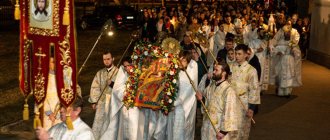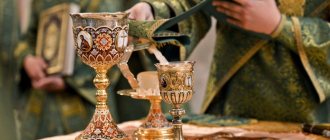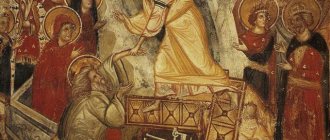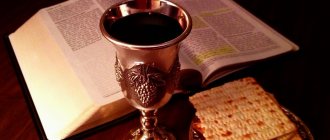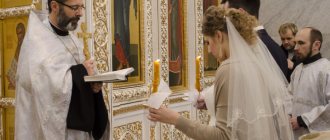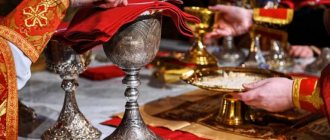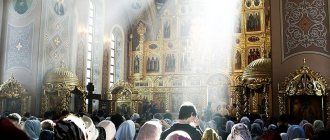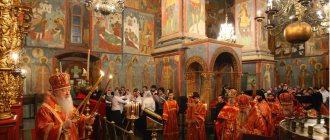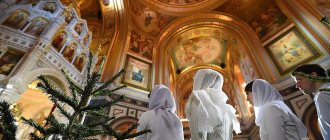Every year Orthodox Christians glorify the name of Christ the Savior and Easter is celebrated in the church, where priests and parishioners proclaim prayers, bless eggs, Easter cakes, and food. This is the most important Orthodox holiday. The celebration begins on Saturday evening and lasts until Sunday morning. They read the Acts of Saints and prayers. Now the service is held according to the same traditions as many centuries ago. One of the important stages is the Procession of the Cross, performed by the priest around the church.
At the same time, the priest sprinkles the parishioners with holy water. For the main Orthodox holiday of Easter, believers prepare in advance. On Thursday, eggs are painted red, sweet cakes are baked, and generously decorated with icing and bright sprinkles.
The festive service begins on Saturday at about 22-23 hours with prayers, then the main part begins - the Procession of the Cross, where the priest sprinkles holy water on the parishioners and the symbols of the holiday they brought. Afterwards comes the completion of Matins, communion, reading of the Liturgy, and the Easter hours begin. This is how the celebration of Easter begins in the church - the celebration of the Resurrection of Christ. It is customary to wear clean, closed clothes in calm tones for such a celebration. Women should wear skirts and cover their heads; men should take off their hats when entering God's house.
Procession
At the end of the first stage of the service, the priest and his flock begin the Procession of the Cross . Participants move from the entrance to God's house, moving against the sun. Along the perimeter of the priest, the participants in the procession are surrounded by parishioners with prepared baskets, where candles are burning, Easter cakes, eggs, donations and other products for the holiday are lying. When moving, the Holy Father generously sprinkles everyone with holy water - sanctifies. After the celebration, the worshipers and clergy enter the temple, accompanying the action with singing.
End of Matins
At the end of Matins, you will see how the clergy begin to christen themselves among themselves in the altar while singing stichera. After this, they share Christ with each of the worshipers, if the temple is small and the number of believers allows it.
Usually in large churches, where many believers come to Easter services, the priest pronounces a short greeting on his own and ends it with three times “Christ is Risen!”, while making the sign of the Cross on three sides, after which he returns to the altar. In the short phrase “Christ is Risen!” lies the whole essence of faith.
Divine Liturgy and the beginning of the Easter Hours
Easter hours, communion - the Divine Liturgy, occur at the end of Matins. Before participating in this process, parishioners who wish to do so are required to receive the priest’s blessing and confess.
After Easter, the Easter Hours are read in church all week in the mornings and evenings. They begin to be recited in church after the Liturgy. Before communion, the priest, with candles in his hand, fumigates the altar and church with censer. During cathedral services, the Gospel is read in different languages by several clergy. Slavic, Russian, ancient Latin, Greek. On which the preaching of the apostles that Christ is Risen was spread. All the time, the celebration of Easter is accompanied by the measured sounds of bells on the belfry. Depending on the stage of the service, their rhythm, number of beats, and motive change.
Beginning of the festive service
Let's start with the question, what time does the church service on Easter begin? So, if you plan to stay awake on Easter night, you should know that the start of the service in the church on Easter starts shortly before midnight, when all churches serve the Midnight Office.
At this time, the priest and the deacon go to the Shroud, censing is performed around it. At the same time, they sing “I will arise and be glorified,” after which they lift the Shroud and take it to the altar.
How is the church service on Easter? There are a number of important points. The Shroud is placed on the Holy Altar, where it must remain until Easter. At these moments, all the clergy in full vestments line up in order at the Throne. Candles are lit in the temple.
Exactly at midnight, with the Royal Doors closed (the double doors opposite the Throne in the altar, the main gate of the iconostasis in an Orthodox church), the clergy quietly sing the stichera (text dedicated to the verses of the psalm) about the resurrection of the Savior of the world.
“Thy Resurrection, O Christ the Savior, the angels sing in heaven, and grant us on earth to glorify You with a pure heart.”
The curtain is opened and the same stichera is sung again, louder. The Royal Doors open. The verse about the resurrection of the Savior is sung in full voice.
What is forbidden to do on Easter Day
According to the Church, some actions on the day of the Holy Resurrection of Christ are strictly prohibited. By deliberately or accidentally breaking prohibitions, you may incur the wrath of the Lord.
Priests name three things that should never be done on Easter
- Quarreling with people around you. Swearing and anger on Easter Day not only does not support the festive mood, but can also lead to complete and final discord with loved ones. Remember the main Christian principle - forgiveness, and try not to offend people dear to you.
- Drink strong alcoholic drinks. Alcohol, which intoxicates the head, can easily turn a believer away from the grace of the Lord and plunge him into sinful vices. The clergy strictly prohibit drinking on Easter Day and advise avoiding this harmful habit in principle.
- Keep the fast. The days of Lent were created specifically to prepare for the holiday of the Bright Resurrection of Christ. Observing asceticism on the day of the holiday means not attaching much importance to it.
Easter Midnight Office
The festive service does not begin immediately at midnight from Saturday to Sunday, but a little earlier, a little later at 23.00.
We enter a darkened temple filled with people. Chandeliers - large chandeliers - are turned off. In front of the closed Royal Doors, on the pulpit there is a large stand in the form of a tomb. On it lies the Shroud - a decorated embroidered cloth with the image of Christ lying in the tomb.
A priest and a deacon in white robes quietly emerge from the altar and a special service begins - the floor at the altar, interspersed with the quiet singing of the choir. Its main part is the priest’s reading of the canon of Holy Saturday, which tells about the burial of Christ. At the end of the reading, incense is burned around the Shroud and, with the words “I will arise and be glorified,” the Shroud is brought into the altar through the open Royal Doors.
A few more prayers and the Midnight Office ends.
Silence again.
Where can you watch the online broadcast of the Easter service?
“Online worship”, of course, cannot replace live participation in the Liturgy, much less the Sacrament of Communion. But the clergy understand with understanding the laity who, for objective reasons, do not have the opportunity to attend the service. These people include believers with disabilities and seriously ill people.
The main Easter service in the Cathedral of Christ the Savior will be led by Patriarch Kirill. The broadcast will be conducted by Channel One. Starts at 23:30.
Every year, Patriarch Kirill leads the Easter service at the Cathedral of Christ the Savior in Moscow. The service from the main Cathedral of the Russian Orthodox Church will begin to be broadcast on central television channels at 23.30 Moscow time. Many regional television channels also plan to show services from local cathedrals on the night of May 1–2.
You can pray at the Easter Vespers, celebrated in churches in the evening on Easter Sunday, by joining the broadcast on the Spas and Soyuz TV channels at 16.00 Moscow time, as well as on the broadcast pages of various parishes of the Russian Orthodox Church in Russia and other countries (check the time on the websites specific temples).
Subject:
- Easter
Easter Day of the Holy Resurrection of Christ
Song 1
Irmos: Day of Resurrection, / let us enlighten people, / the Passover of the Lord, Easter: / from death to life, / and from earth to heaven, / Christ God has brought us, / / singing in victory.
Resurrection day, let us enlighten people; Easter, the Lord's Easter, for from death to life and from earth to heaven, Christ God has raised us up, singing the song of victory.
Chorus: Christ is risen from the dead.
Let us purify our senses,/ and see with the unapproachable light of the resurrection,/ Christ shining,/ and saying “rejoice,”/ let us hear clearly,// singing victoriously.
Let us purify our senses and see Christ, shining with the unapproachable light of the resurrection, and, singing the song of victory, let us hear clearly from Him: “Rejoice.”
Chorus: Christ is risen from the dead.
Let the heavens rejoice worthily,/ let the earth rejoice,/ let the world celebrate,/ all visible and invisible:/ Christ has risen,// eternal joy.
Let heaven worthily rejoice, let earth rejoice, and let the whole world, visible and invisible, celebrate, for Christ has risen - Eternal Rejoicing.
Katavasia: Resurrection day...
On each song, according to the chaos - Christ is risen the final three times. Small litany, and exclamation: For Thy power...
Song 3
Irmos: Come, we drink new beer, / not from a barren stone / that works wonders, / but an incorruptible source, / from the tomb of Christ, / in it we are established.
Come, let us drink a new drink, not miraculously produced from a barren stone (Num. 20:8-11), but a source of immortality, produced from the tomb by Christ, on whom we are established.
Now everything is filled with light, / heaven and earth / and the underworld: / let all creation celebrate / the rise of Christ, / / established in Him.
Now everything is filled with light: heaven, earth and the underworld; Let all creation celebrate the rebellion of Christ, on whom it is founded.
Yesterday I was buried with You, Christ, / I stand with You today / I will rise again with You, / I was crucified with You yesterday: / glorify me yourself, O Savior, // in Your Kingdom.
Yesterday I was buried with You, Christ, today I rise with You, the Risen One: I was crucified with You yesterday, glorify me with You, You Yourself, Savior, in Your Kingdom.
Small litany and exclamation: For You are our God...
Ipakoi, ch. 8:
Having preceded the morning of Mary, / and having found the stone rolled away from the tomb, I hear from the Angel: / in the light of the ever-present, / that you seek with the dead, like a man; / you see the grave linens, you speak, and preach peace, / as the Lord who put to death has risen death, // for he is the Son of God, saving the human race.
The women who came with Mary before the sun (before dawn) and found the stone rolled away from the tomb, heard from the Angel: why are you looking for, as a man, among the dead the One who lives in eternal light? Look at the burial shrouds and hasten to proclaim to the world that the Lord has risen, putting to death death, for He is the Son of God, saving the human race.
Song 4
Irmos: On the Divine guard / may the God-speaking Habakkuk / stand with us, / and show a luminous Angel, / clearly saying: / today is the salvation of the world, / as Christ is risen, / as he is omnipotent.
May the Prophet of God Habakkuk stand with us on the Divine guard (Hab. 2, 3) and show us an Angel shining with light, loudly saying: Today is salvation for the world, for Christ has risen as the Almighty.
The male sex, / as if he had opened the virgin womb, / Christ appeared, as if he were a man; / the lamb was called, / but without blemish, because he did not taste filth: / our Passover, / and as God is true, / / the word was perfect.
Christ - our Easter - appeared in the flesh as the male sex, opening the virgin womb; as offered as food, He is called the Lamb; as a stranger to defilement - blameless (Ex. 12:5); and as the True God, He is called perfect.
Like a one-year-old lamb, / Christ, the blessed crown for us, / was slain quickly for all: / The cleansing Passover, / and the red pack from the tomb // The Sun of Truth has risen for us.
Our blessed crown, Christ, like a one-year-old Lamb, voluntarily submitted to the slaughter, for all the cleansing Passover, and again shone for us from the grave - the red Sun of Truth.
Small litany and exclamation: For God is good and a lover of mankind...
Song 5
Irmos: Let us deepen the morning, / and instead of peace we will bring a song to the Lady, / and we will see Christ / The Sun of Truth, / / life shining for all.
Let us rise early in the morning and, instead of peace, bring a song of praise to the Lord and see Christ, the Sun of Truth, enlightening everyone with life.
Thy immeasurable compassion, / contain the bonds of hell, / walk towards the light, O Christ, / with cheerful feet, / / praising the eternal Easter.
Bound by the bonds of hell, seeing Your immeasurable mercy, O Christ, joyfully rushed towards the light with praises of eternal Easter.
Let us come, O luminaries,/ to Christ proceeding from the tomb like a bridegroom,/ and let us celebrate with lustful rites // God’s saving Easter.
Let us go with lamps in our hands to meet Christ emerging from the tomb as the Bridegroom, and joyfully together with the celebrating ranks of Angels we will celebrate God’s saving Easter.
Small litany and exclamation: For sanctified and glorified is Your most honorable and magnificent name, the Father, and the Son, and the Holy Spirit...
Song 6
Irmos: Thou hast descended into the nether regions of the earth,/ and shattered the eternal faiths that contain the bound, O Christ,/ and thou hast risen from the grave, like Jonah from the whale.
You descended, Christ, into the underworld of the earth and broke the eternal locks that held the prisoners, and on the third day You, like Jonah from the whale (Jon. 2:1.11), rose from the grave.
Having preserved the signs of Christ intact,/ you rose from the grave,/ the keys of the Virgin were not harmed in your birth,/ and you opened for us // the doors of heaven.
You, Christ, who did not damage the seal of virginity at Your birth, rose from the grave, keeping its seals intact, and opened the doors of heaven to us.
My Savior, the living and non-sacrificial slaughter, / as God himself / brought to the Father by will, / you resurrected the all-begotten Adam, / / rose from the grave.
My Savior, living and, like God, unslaughtered sacrifice, having offered Yourself voluntarily as a sacrifice to the Father and resurrected from the grave, You raised with You the common ancestor Adam.
Small litany and exclamation: You are the King of the world, and the Savior of our souls...
Kontakion, ch. 8:
Even though you descended into the grave, O Immortal One, / but you destroyed the power of hell, / and you rose again as a conqueror, Christ God, / saying to the myrrh-bearing women: Rejoice, / and grant peace to your apostles, / grant resurrection to the fallen.
Although You, the immortal One, descended into the grave, You destroyed the power of hell and rose again victorious, O Christ God, saying to the myrrh-bearing women: Rejoice, and having granted peace to Your Apostles; giving resurrection to the fallen.
Ikos:
Even before the sun, the Sun sometimes set in the tomb, / leading up to the morning, / looking for the Myrrh-Bearing Virgin like the day, / and crying out to friends to friends: / O friends, come, let us anoint the life-giving and buried body with stinks, / the flesh of the resurrected fallen Adam, lying in the tomb./ We come, sweating like wolves, / and we will worship, and we will offer peace like gifts, / not wrapped in swaddling clothes, but entwined in a shroud, / and we will weep and cry out: / O Master, arise, / grant resurrection to the fallen.
Once upon a time, the myrrh-bearing virgins, even before morning, sought, like daylight, the Sun, which existed before the sun and went into the grave. They said to one another: Oh, friends, let's go, let's anoint with fragrances the body that exudes life and is buried, the flesh of Him who lies in the tomb and raises the fallen Adam. Let us go, let us hasten, like the Magi, bow down and offer a gift of myrrh to the One entwined not with shrouds, but with funeral linen; Let us shed tears and exclaim: Arise, Lord, who gives resurrection to the fallen.
Having seen the Resurrection of Christ,/ let us worship the holy Lord Jesus,/ the only sinless one./ We worship Thy Cross, Christ,/ and we sing and glorify Thy holy resurrection:/ For Thou art our God,/ Do we know no other to Thee,/ We call Thy name./ Come All the faithful,/ let us worship the holy resurrection of Christ:/ behold, joy has come through the Cross to the whole world./ Always blessing the Lord,/ we sing of His resurrection:/ having endured crucifixion,// destroy death through death (three times).
Having seen the Resurrection of Christ, let us worship the Holy Lord Jesus, the One Sinless. We worship Your Cross, O Christ, we sing and glorify Your Holy Resurrection, for You are our God, we know no other but You, we call upon Your name. Come, all you faithful, let us worship the Holy Resurrection of Christ, for through the Cross joy has come to the whole world. Always praising the Lord, we will glorify His resurrection, for He, having endured crucifixion, conquered death by His death.
Jesus rose from the grave, / as he prophesied, / to give us eternal life, / and great mercy (three times).
Jesus, having risen from the grave, as He predicted, gave us eternal life and great mercy.
Song 7
Irmos: He who delivered the youths from the furnace,/ having become a man,/ suffers as if mortal,/ and with mortal passion,/ clothes in incorruptibility with splendor,/ God alone is blessed of the fathers,// and glorified.
He who delivered the youths from the oven (Dan. 3), having become a man, suffers like a mortal, and with His suffering clothes mortals in the beauty of immortality. This is the One Blessed God of the fathers and the Most Glorified.
Women from the world of the God-wise / follow You in their footsteps: / Whom, as if dead, I seek with tears, / bowing down, rejoicing in the living God, / and the secret Pascha // To Yours, Christ, the disciple of the gospel.
The women, wise by God, hurried after You with fragrant ointment. But Whom they sought with tears, as if dead, They worshiped Him with joy, as the Living God, and announced the mystical Easter to Thy disciples, O Christ.
In death we celebrate the mortification, / hellish destruction, / the beginning of another eternal life, / and playfully sing of the Guilty One, / the only one blessed by the fathers of God // and most glorified.
We celebrate the mortification of death, the destruction of hell, the beginning of another, eternal life, and in delight we glorify the Author, the One Blessed God of the fathers and the Most Glorified.
Small litany and exclamation: May the power of Your Kingdom be blessed and glorified...
Song 8
Irmos: This is the appointed and holy day, / there is one king and lord of the Sabbath, / a feast of holidays, / and a triumph is a triumph // on which we bless Christ forever.
This famous and holy day, the main and dominant one over all Saturdays, is a holiday of holidays and a triumph of celebrations; On this day we will bless Christ forever.
Come, new birth of the vine, / Divine joy, / in the deliberate days of resurrection, / Let us partake of the Kingdom of Christ, / singing of Him, // as God forever.
Come, on the glorious day of resurrection let us partake of the new fruit of the vine, Divine joy, the kingdom of Christ, praising Him as God forever.
Lift up your eyes around, O Zion, and see:/ behold, I have come to you,/ like the bright light of God,/ from the west, and the north, and the sea,/ and the east, your children,// in you blessing Christ forever.
Lift up your eyes, O Zion, look around you: behold, your children have flocked to you (Isa. 49:18; 60:4), like lights kindled by God Himself, from the west, north, south and east, blessing Christ in you forever.
Small litany and exclamation: For Thy name is blessed, and Thy kingdom is glorified...
Song 9
On the 9th song we sing irmos and troparia with choruses.
The deacon sings the chant: My soul magnifies Christ, the giver of life, who rose three days from the grave.
My soul glorifies Christ the Giver of Life, who rose from the grave on the third day.
Irmos: Shine, shine, / new Jerusalem: / for the glory of the Lord / is upon you, / rejoice now, / and rejoice, O Zion! / You, Pure One, show off, O Mother of God, // about the rise of Your Nativity.
Shine, shine, new Jerusalem, for the glory of the Lord has shone upon You; rejoice now and be glad, O Zion (Isa. 60: 1-2); and You, Pure Mother of God, rejoice in the resurrection of the One born of You.
Chorus: Christ is the new Easter, living sacrifice, Lamb of God, take away the sins of the world.
Christ is the new Passover, the living Sacrifice, the Lamb of God who took away the sins of the world.
Troparion: O Divine, O dear, / O Thy sweetest voice! / You have truly promised to be with us / until the end of the century, O Christ: / His faithfulness, / the affirmation of hope // that we have, we rejoice.
Oh, how Divine, gracious and sweet is Your word, O Christ, You unfaithfully promised to be with us until the end of the age (Matthew 28:20); Having this as a support for hope, we, the faithful, rejoice.
Chorus: Magdalene Maria came to the tomb, and saw Christ, like a heli-grader, she asked.
Mary Magdalene ran to the tomb and, seeing Christ, began to ask Him, mistaking Him for a gardener.
Troparion: O great and most sacred Easter, Christ! / About Wisdom, / and the Word of God, and Power! / Grant us / the opportunity to partake of You, / in the non-evening days // of Your Kingdom.
Oh, great and most sacred Easter, Christ. O Wisdom, Word of God and Power, grant us the honor of more fully communing with You on the ever-bright day of Your Kingdom.
Chorus: The angel cries out with more grace: pure Virgin, rejoice! And again the river: Rejoice! Your Son is risen three days from the grave, and having raised the dead, people rejoice.
The angel exclaimed to the Blessed One: Pure Virgin, rejoice, and I repeat: Rejoice, Your Son rose on the third day from the grave, raising the dead. People rejoice.
Katavasia: Glow, glow...
Small litany and exclamation: For all the powers of heaven, the Father, and the Son, and the Holy Spirit, praise You, and they send up glory to You, now and ever, and unto the ages of ages.
Exapostilary (luminous):
Having fallen asleep in the flesh, / as if dead, / King and Lord, / you have risen for three days, / raised Adam from aphids, / and abolished death: / Easter incorruptibility, / / the salvation of the world (three times).
Having fallen asleep in the flesh as a mortal, You, the King and Lord, rose again on the third day, resurrecting Adam from corruption and abolishing death, the Easter of immortality, the salvation of the world.
Stichera on Praise, ch. 1:
Let every breath praise the Lord,/ praise the Lord from heaven,/ praise Him in the highest.// A song befits you, O God.
Praise Him, all His angels,/ Praise Him, all His might.// A song befits You, O God.
Verse: Praise Him according to His strength, praise Him according to the abundance of His majesty.
We sing Your saving passion, O Christ, // and glorify Your resurrection.
Easter verses:
Verse 1: Let God rise again, and let His enemies be scattered.
Easter / sacred has appeared to us today;/ New holy Easter;/ Mysterious Easter;/ All-honorable Easter;/ Easter Christ the Redeemer;/ Immaculate Easter;/ Great Easter;/ Easter of the faithful:/ Easter opening the doors of heaven to us // Easter sanctifying the faithful .
Today the sacred Pascha, the newly holy Pascha, the mysterious Pascha, the all-honorable Pascha, the Pascha of Christ the Redeemer, the immaculate Pascha, the great Pascha, the Pascha for the faithful, the Pascha that opens the doors of heaven to us, the Pascha that sanctifies all the faithful, has been revealed to us.
Verse 2: As the smoke disappears, let them disappear.
Come / from the vision of the wife of the gospel, / and cry to Zion: / receive from us the joys of the annunciation / of the resurrection of Christ; / show off, rejoice, / and rejoice, O Jerusalem, / having seen the King Christ from the tomb, / / like a bridegroom coming.
Go after the vision, wife of the gospel, and tell Zion: receive from us the joyful and good news of the resurrection of Christ. Rejoice, rejoice, and rejoice, O Jerusalem, when you see the King Christ emerging from the tomb as the Bridegroom.
Verse 3: So let sinners perish from the presence of God, and let righteous women rejoice.
The myrrh-bearing woman, / in the deep morning / presented herself to the tomb of the Life-Giver, / found an Angel / sitting on a stone, / and having preached to them, / said to her: / that you seek the living with the dead; / that you weep for the incorruptible in ashes; / as you go, preach as His disciple .
The myrrh-bearing women, who ran to the tomb of the Giver of Life early in the morning, found an Angel sitting on a stone, and he addressed them with the following words: Why are you looking for the Living One among the dead, that you are mourning the Imperishable One, as if given over to corruption. When you return, tell His disciples.
Verse 4: In this day which the Lord has made, let us rejoice and be glad.
Red Easter!/ Easter!/ The Lord's Easter!/ The all-honorable Easter has risen to us!/ Easter!/ Let us embrace each other with joy./ O Easter!/ deliverance from sorrow,/ for from the grave this day,/ as from the palace/ Christ has risen,/ women of joy fulfill the verb // preach as an apostle.
Easter is red (beautiful)! Easter - the Lord's Easter - the all-honorable Easter has dawned on us. Easter! Let's hug each other joyfully. Oh Easter! Deliverance from sorrow, for today Christ came out of the tomb radiant, as from a bridal chamber, and filled the wives with joy with the words: Tell the Apostles.
Glory to the Father, and the Son, and the Holy Spirit, now and ever, and unto ages of ages. Amen.
Resurrection day, / and we will be enlightened by triumph, / and we will embrace each other, / with our lips, brethren, / and to those who hate us: / we will forgive all through the resurrection, / and thus we will cry out: / Christ is risen from the dead, trampling down death by death, and giving life to those in the tombs .
Resurrection day! Let us be enlightened by triumph and embrace each other; Let us also say to those who hate us: Brothers, let us forgive everything for the sake of the resurrection, and let us exclaim like this: Christ has risen from the dead, having conquered death by death and giving life to those in the tombs.
And we sing Christ is risen three times and many times: everyone kisses each other.
How to behave in the temple
When entering the church, you must cross yourself three times with bows from the waist: with three fingers only with your right hand. Be sure to take off your gloves when doing this. Men must remove their hats.
If you want to contact a priest, you must first say: “Father, bless!” After this you can ask a question. When accepting a blessing, fold your palms crosswise - palms up, right to left, and kiss the right hand of the clergyman, who is blessing you.
The temple, especially on Easter night, is a special place where a spiritual sacrament occurs. Therefore, you should behave accordingly. Remember that while the church service is ongoing, it is not recommended to turn your back to the altar.
If you come with a child, explain to him in advance that you need to be quiet here, you can’t talk loudly or laugh. Do not use a mobile phone in the temple and do not allow a child to do so. Switch the device to silent mode. While the Easter service is going on, you should be focused solely on this.
While you are standing among other believers during the service, and the priest overshadows you with the cross, the Gospel and the image during the reading, at this moment you need to bow slightly. It is customary to sign the sign of the cross at the moment when you hear the words: “Lord, have mercy,” “In the name of the Father and the Son and the Holy Spirit,” “Glory to the Father and the Son and the Holy Spirit.”
When leaving the temple, cross yourself three times, make three bows from the waist when leaving the temple and when leaving the church gate, turning your face to the temple.
A year later of the pandemic
Last year Easter took place in difficult conditions. On the one hand, a pandemic was raging, for which no vaccine had yet been created. On the other hand, believers wanted to celebrate an important holiday for them in compliance with all traditions. Patriarch Kirill then called on believers to temporarily refrain from visiting churches.
This year, no restrictions are expected yet, except for the restriction on believers kissing icons and crosses. As the rector of the Church of the Forty Sebastian Martyrs in Spasskaya Sloboda, Archpriest Maxim Pervozvansky, explained, priests should simply bless with the cross and touch the head.
In churches, communion spoons will be disinfected or disposable ones will be used. On the website of the Moscow Diocese of the Russian Orthodox Church it is also recommended to distribute to believers a prayer “in times of harmful pestilence,” supplementing the home rule with it.
Nevertheless, I would like to believe that the majority of believers will worry about their health and the safety of others. You can also use, if not masks, then at least transparent protective shields. They will practically not drown out the voices of those praising Christ, but they will prevent infection by airborne droplets.
When is the earliest and latest celebration of Orthodox Easter according to the new style?
The earliest spring full moon coincides with April 4 (March 22), and the latest with May 2 (April 19). ... Therefore, Easter is celebrated from April 4 (March 22) to May 8 (April 25), and all 35 days on which it occurs.
Interesting materials:
Who owns the Okhotny Ryad shopping center? Who owns Ubisoft? Who did Tony lose to? Who is Jerusalem artichoke contraindicated for? Who is contraindicated for pumpkin juice? Who needs the manager? Why is horse chestnut called that? Consolidated what is it? Copy to clipboard what is this? Why is the Lithuanian braid called that?
How the Divine Service takes place on Easter, the procession on Easter
Easter services are especially solemn. “Christ is risen: eternal joy,” sings the Church in the Easter canon.
Since ancient, apostolic times, Christians have been awake on the sacred and pre-festive saving night of the Bright Resurrection of Christ, the luminous night of a luminous day, awaiting the time of their spiritual liberation from the work of the enemy (Church Charter on the week of Easter).
Shortly before midnight, a midnight office is served in all churches, at which the priest and the deacon go to the Shroud and, having censed around it, while singing the words of the katavasia of the 9th song, “I will arise and be glorified,” they lift the Shroud and take it to the altar. The Shroud is placed on the Holy Altar, where it must remain until Easter.
Easter Matins, “the joy of the Resurrection of our Lord from the dead,” begins at 12 o’clock at night. As midnight approaches, all clergy in full vestments stand in order at the Throne. The clergy and worshipers light candles in the temple. On Easter, just before midnight, a solemn bell announces the onset of the great minute of the Luminous Feast of the Resurrection of Christ. In the altar, quiet singing begins, gaining strength: “Thy Resurrection, O Christ the Savior, the angels sing in heaven, and grant us on earth to glorify You with a pure heart.” At this time, jubilant Easter peals ring out from the height of the bell tower.
The procession of the cross, which takes place on Easter night, is a procession of the Church towards the risen Savior. The religious procession takes place around the temple with continuous pealing. In a bright, jubilant, majestic form, while singing “Thy Resurrection, Christ the Savior, the Angels are singing in heaven, and grant us on earth to glorify You with a pure heart,” the Church, like a spiritual bride, walks, as they say in sacred chants, “with merry feet to meet Christ coming out of the tomb like a bridegroom.”
In front of the procession they carry a lantern, behind it an altar cross, an altarpiece of the Mother of God, then in two rows, in pairs, banner bearers, singers, candle bearers with candles, deacons with their candles and censers, and behind them priests. In the last pair of priests, the one on the right carries the Gospel, and the one on the left carries the icon of the Resurrection. The procession is completed by the primate of the temple with a triveshnik and a Cross in his left hand.
If there is only one priest in the church, then the laity carry the icons of the Resurrection of Christ and the Gospel on the shrouds.
Having walked around the temple, the procession stops in front of closed doors, as before the entrance to the Cave of the Holy Sepulcher. Those who carry shrines stop near the doors, facing west. The ringing stops. The rector of the temple and the clergy sing the joyful Easter troparion three times: “Christ is risen from the dead, trampling down death by death and giving life to those in the tombs” ( Easter hymns in mp3 ).
This song is picked up and sung three times by other priests and the choir. Then the priest recites the verses of the ancient prophecy of St. King David: “May God rise again and let His enemies be scattered…”, and the choir and people in response to each verse sing: “Christ is risen from the dead...”
Then the clergy chant the following verses:
“May God rise again, and let His enemies be scattered. And let those who hate Him flee from His face.” “As smoke disappears, let them disappear as wax melts before fire.” “So let sinners perish at the face of God, and let righteous women rejoice.” “This day which the Lord has made, let us rejoice and be glad in it” .
For each verse, the singers sing the troparion “Christ is Risen .
Then the primate or all the clergy sing “Christ is risen from the dead, trampling down death by death . The singers end with “And giving life to those in the tombs .
The church doors open, and the procession of the cross with this joyful news marches into the temple, just as the myrrh-bearing women went to Jerusalem to announce to the disciples about the Resurrection of the Lord.
While singing: “Christ is risen from the dead, trampling down death by death and giving life to those in the tombs,” the doors open, worshipers enter the church, and the singing of the Easter canon begins.
Easter Matins is followed by the Divine Liturgy and the consecration of artos - special bread with the image of the Cross or Resurrection of Christ (it is stored in the church until the next Saturday, when it is distributed to believers).
During the service, the priest again and again joyfully greets all those praying with the words “Christ is Risen!” and every time the worshipers answer: “Truly He is Risen!” At short intervals, the clergy change vestments and walk around the temple in red, yellow, blue, green and white vestments.
At the end of the service, the catechetical word of St. John Chrysostom . In the evening of Easter, an amazingly beautiful and joyful Easter Vespers is served.
Easter is celebrated for seven days, that is, the whole week, and therefore this week is called Bright Easter Week. Each day of the week is also called bright - Bright Monday, Bright Tuesday. The Royal Doors are open all week. There is no fasting on Holy Wednesday and Friday.
Throughout the entire period before the Ascension (40 days after Easter), Orthodox Christians greet each other with the greeting “Christ is Risen!” and the answer “Truly He is Risen!”
The Easter holiday was established back in the Old Testament in memory of the deliverance of the Jewish people from Egyptian slavery. The ancient Jews celebrated Passover on Nisan 14–21 – the beginning of our March.
In Christianity, Easter is the Resurrection of the Lord Jesus Christ, the Celebration of the victory of life over death and sin. Orthodox Easter is celebrated on the first Sunday after the spring full moon, which occurs on or after the vernal equinox, but not earlier than the vernal equinox.
UNTIL the end of the 16th century, Europe lived according to the Julian calendar, and in 1582 Pope Gregory XIII introduced a new style - the Gregorian, the difference between the Julian and Gregorian calendars is 13 days. The Orthodox Church does not switch to the Gregorian calendar, since the celebration of Easter according to this calendar may coincide with the Jewish Passover, which contradicts the canonical rules of the Orthodox Church. In some countries, for example in Greece, where the Orthodox Church switched to the Gregorian calendar, Easter is still celebrated according to the Julian calendar.
What is the Easter canon
Easter canon, creation of St. John of Damascus, which forms the most essential part of Easter Matins - the crown of all spiritual songs.
The Easter canon is an outstanding work of church literature not only in terms of the splendor of its external form, but also in its internal merits, in the strength and depth of the thoughts contained in it, in the sublimity and richness of its content. This deeply meaningful canon introduces us to the spirit and meaning of the very holiday of the Resurrection of Christ, makes us fully experience and understand this event in our souls.
At each song of the canon, incense is performed, the clergy with a cross and censer, preceded by lamps, go around the entire church, filling it with incense, and joyfully greet everyone with the words “Christ is Risen!”, to which the believers respond “Truly He is Risen!” These numerous departures of priests from the altar remind us of the frequent appearances of the Lord to His disciples after the Resurrection.



